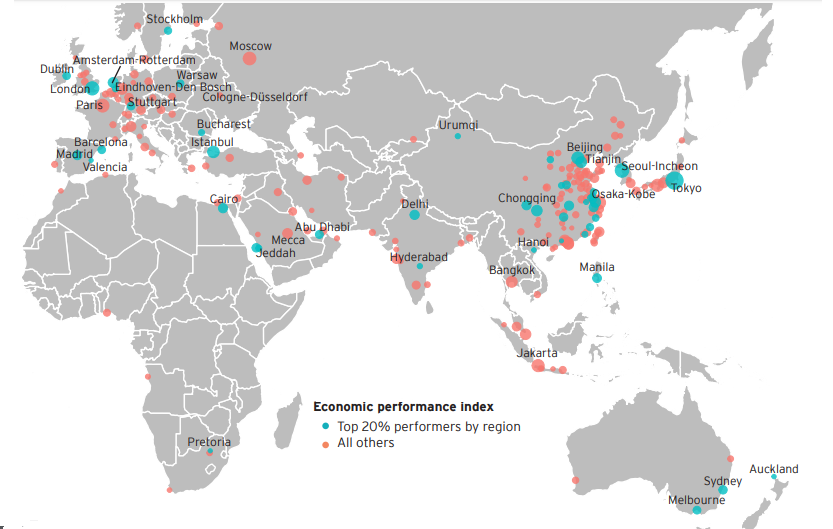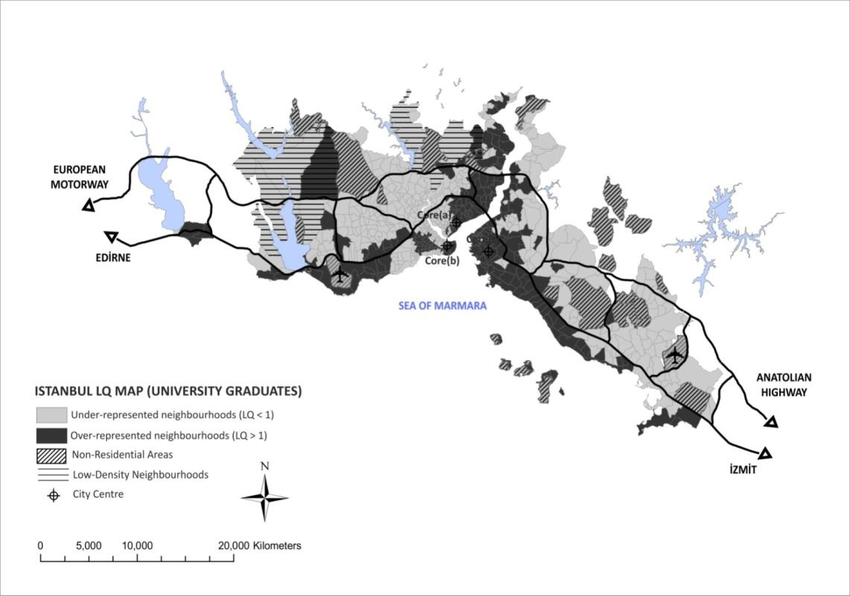Economy of Istanbul
Istanbul is an economically developed city that combines the industry, tourism, and transportation sectors. Its GDP in 2017 amounted to one-third of Turkey’s GDP, or 970 billion Turkish liras (Kistak, 2018). The beneficial geographical location of Istanbul, as well as the history of its economic development and international trade, allow it to remain one of the most successful and important cities in the country and region.
The size of Istanbul and its location near the sea and at the intersection of two civilizations allow it to develop different sectors of the economy. For this reason, Istanbul has the highest economic performance in the region (Bouchet et al., 2018). The city also ranks in the top twenty cities with the highest development index, as shown in Figure 1. The main sectors of the economy are transportation, tourism, and industry. Tourism for Istanbul is one of the most important sources of profit, and the number of tourists from 2000 to 2016 has increased from 10 to 31 million (Cetin et al., 2017). These numbers continue to grow because Istanbul combines the culture of two civilizations, history and modernity, and also excellent service. The transportation sphere also develops as the geographical location allows the city to use sea and land transport, and the construction of new airports increases the possibility of transit (Kahraman & Alkan, 2018). Thus, Istanbul is an economically developed town that has the potential to achieve the level of a global city.
Demographics of Istanbul
Istanbul is a town located at the crossroads of Europe and Asia, so the diversity of its population is logical. The city is inhabited by people mostly of one religion, ethnic group, and social level. However, hundreds of residents and migrants of different nationalities also live in both elite and ghetto areas in Istanbul.
Istanbul is geographically divided into European and Asian parts and consists of many districts. Turks are the dominant ethnicity; however, the metropolis is also inhabited by Kurdish people, Armenians, Arabs, Jews, and European nationalities (Eraydın et al., 2018). This fact also causes religious diversity because, except for Muslims, there are also representatives of Judaism and Christianity. The city has many refugees from Iraq, Iran, and Syria, but only 8.3% of the population are foreigners (Eraydın et al., 2018). In general, the population is mixed and inhabit Istanbul regardless of their group, although there are national communities and areas. Segregation is more noticeable in social classes by income level, since the districts are conditionally divided into those in which people with higher education and high income live and those where residents have a low level of education (Ataç, 2015; Ataç, 2017). Moreover, these districts most often do not even have common borders, as can be seen in Figure 2. Some areas are mainly inhabited by refugees and outcasts of society (Cox, 2016). These places are ghettos as people there always express stigma, isolation, restrictions. Thus, officially, the city is not subject to segregation, but it exists daily.
References
Ataç, E. (2015). Segregation in Istanbul: Measuring segregation in an ever-changing city. Przestrzeń Społeczna (Social Space), 9(1), 35-62.
Ataç, E. (2017). Turkish-style segregation. Asian Journal of Social Science, 45(3), 235–270.
Bouchet, M., Liu, S., Parilla, J., & Kabbani. N. (2018). Global metro monitor 2018. The Metropolitan Policy Program at Brookings. Web.
Cetin, G., Alrawadieh, Z., Dincer, M., Dincer, F. I., & Ioannides, D. (2017). Willingness to pay for tourist tax in destinations: Empirical evidence from Istanbul. Economies, 5(2), 21.
Cox, D. (2016). Syria’s most hated refugees find sanctuary in an Istanbul ghetto. The Guardian. Web.
Eraydın, A., Demirdag, I., Güngördü, F.N., and Yenigün, Ö. (2017). DIVERCITIES: Dealing with urban diversity – The case of Istanbul. Middle East Technical University, Ankara. Web.
Kahraman, C., & Alkan, G. (2018). Istanbul’s third airport in terms of transportation Geography: Geopolitics, Regional, And Economic Effects. PEOPLE: International Journal of Social Sciences, 3(3), 1252–1261.
Kistak, S. (2018). Analysis: Is Istanbul economically too strong? Daily News. Web.
Appendix

